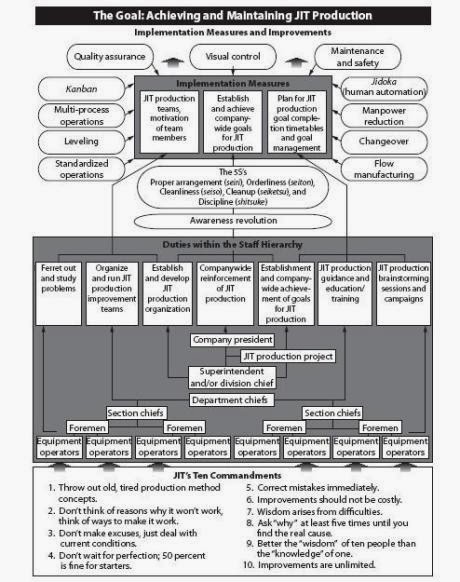Just in
time production (JIT): the other big pilar…
It originally referred to the production of goods
to meet customer demand exactly, in time, quality and quantity, whether the
`customer’ is the final purchaser of the product or another process further
along the production line.
It has now come to mean producing with minimum
waste “Muda” ; variation “Mura” & Overburden “Muri” .
Waste ,is taken in its most general sense and
includes time and resources as well as materials. Elements of JIT include:
• Continuous improvement.
◦
Attacking
fundamental problems – anything that does not add value to the product.
◦
Devising systems
to identify problems.
◦
Striving for
simplicity – simpler systems may be easier to understand, easier to manage and
less likely to go wrong.
◦
A product oriented
layout – produces less time spent moving of materials and parts.
◦
Quality control at
source – each worker is responsible for the quality of their own output.
◦
Poka-yoke – `foolproof’
tools, methods, jigs etc. prevent mistakes
◦
Preventative
maintenance, Total productive maintenance – ensuring machinery and equipment
functions perfectly when it is required, and continually improving it.
• Eliminating waste. There are 7 types of waste:
◦
waste from
overproduction.
◦
waste of waiting
time.
◦
transportation
waste.
◦
processing waste.
◦
inventory waste.
◦
waste of motion.
◦
waste from product
defects.
• Eliminating variation. There are 3 types of
variation:
◦
Variation from
Process.
◦
Variation from Material.
◦
Variation from
Information.
• Eliminating Overburden. There are 3 types of Overburden:
◦
Overburden of Machines.
◦
Overburden of
people
◦
Overburden of
system
• Good housekeeping – workplace cleanliness and
organisation.
• Set-up time reduction – increases flexibility and
allows smaller batches. Ideal batch size is 1item. Multi-process handling – a
multi-skilled workforce has greater productivity, flexibility and job
satisfaction.
• Levelled / mixed production – to smooth the flow of
products through the factory.
• Kanbans – simple tools to `pull’ products and
components through the process.
• Jidoka (Autonomation) – providing machines with the
autonomous capability to use judgement, so workers can do more useful things
than standing watching them work.
Andon (trouble lights) – to
signal problems to initiate corrective action.
Fig.
Hence we can see that to have a Total JIT
manufacturing system, a company-wide commitment, proper materials, quality,
people and equipments must always be made available when needed. In addition;
the policies and procedures developed for an internal JIT structure
should also be extended into the company’s supplier and customer base to
establish the identification of duplication of effort and performance feedback
review to continuously reduced wastage and improve quality. By integrating the
production process; the supplier, manufacturers and customers become an
extension of the manufacturing production process instead of independently
isolated processes where in fact in clear sense these three sets of
manufacturing stages are inter-related and dependent on one another. Once
functioning as individual stages and operating accordingly in isolated
perspective; the suppliers, manufacturers and customers can no longer choose to
operate in ignorance. The rules of productivity standards have changed to shape
the economy and the markets today; every company must be receptive to changes
and be dynamically responsive to demand. In general, it can be said that there
is no such thing as a KEY in achieving a JIT success; only a LADDER;
where a series of continuous steps of dedication in doing the job right every
time is all it takes.
Fig.





No hay comentarios.:
Publicar un comentario